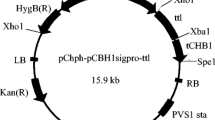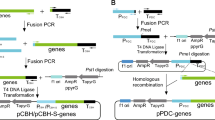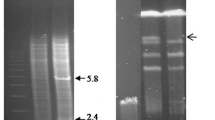Abstract
We successfully isolated a lipase gene (designated lipPA) directly from the genomic DNA of an Antarctic isolate of Penicillium allii using PCR and a suite of degenerate primers specifically designed to target two conserved regions of fungal lipase genes. We applied the biolistic transformation system to successfully integrate the lipPA gene into a heterologous fungal host, Trichoderma reesei, one of the most powerful secretors of extracellular proteins, and induced the transformant to secrete an active lipase into the growth medium. The recombinant lipase had a temperature optimum of 25 °C at pH 7.9 and retained greater than 50% of the maximum activity from 10 °C to 35 °C and over a pH range from 4.0 to 8.5.



Similar content being viewed by others
References
Bailey MJ, Nevalainen KMH (1981) Induction, isolation, and testing of stable Trichoderma reesei mutants with improved production of solubilizing cellulase. Enzyme Microb Technol 3:153–157
Bell PJL, Sunna A, Gibbs MD, Curach NC, Nevalainen H, Bergquist PL (2002) Prospecting for novel lipase genes using PCR. Microbiology 148:2283–2291
Bergquist PL, Te′o VSJ, Gibbs MD, Cziferszky ACE, Faria FP de, Azevedo MO, Nevalainen KMH (2002) Production of recombinant bleaching enzymes from thermophilic microorganisms in fungal hosts. Appl Biochem Biotechnol 98:165–176
Bornscheuer UT, Bessler C, Srinivas R, Krishna SH (2002) Optimising lipases and related enzymes for efficient application. Trends Biotechnol 20:433–437
Britton HS, Robinson RA (1931) Universal buffer solutions and the dissociation constant of veronal. J Chem Soc 1931:1456–1462
Brzozowski AM, Savage H, Verma CS, Turkenburg JP, Lawson DM, Svendsen A, Patkar S (2000) Structural origins of the interfacial activation in Thermomyces (Humicola) lanuginosa lipase. Biochemistry 39:15071–15082
Chung GH, Lee YP, Jeohn GH, Yoo OJ, Rhee JS (1991) Cloning and nucleotide sequence of thermostable lipase gene from Pseudomonas fluorenscens. Agric Biol Chem 55:2359–2365
Eggert T, Pancreac′h G, Douchet I, Verger R, Jaeger K-E (2000) A novel extracellular esterase from Bacillus subtilis and its conversion to a monoacylglycerol lipase. Eur J Biochem 267:6459–6469
Faria FP de, Te′o VSJ, Bergquist PL, Azevedo MO, Nevalainen HKM (2002) Expression and processing of a major xylanase (XYN2) from the thermophilic fungus Humicola grisea var. thermoidea in Trichoderma reesei. Lett Appl Microbiol 34:119–123
Fojan P, Jonson PH, Petersen MTN, Petersen SB (2000) What distinguishes an esterase from a lipase: a novel structural approach. Biochimie 82:1033–1041
Godfrey T, West S (1996) Industrial enzymology, 2nd edn. Macmillan Press, London
Herggård S, Gibas CJ, Subramaniam S (2000) Role of an electrostatic network of residues in the enzymatic action of the Rhizomucor miehei lipase family. Biochemistry 39:2921–2930
Jaeger K-E, Ransac S, Dijkstra BW, Colson C, Heuvel M van, Misset O (1994) Bacterial lipases. FEMS Microbiol Rev 15:29–63
Jaeger K-E, Dijkstra BW, Reetz MT (1999) Bacterial biocatalysts: molecular biology, three-dimensional structures, and biotechnological applications of lipases. Annu Rev Microbiol 53:315–351
Kouker G, Jaeger K-E (1987) Specific and sensitive plate assay for bacterial lipases. Appl Environ Microbiol 53:211–213
Morris DD, Reeves RA, Gibbs MD, Saul DJ, Bergquist PL (1995) Correction of the β-mannanase domain of the celC pseudogene from Caldocellulosiruptor saccharolyticus and activity of the gene product on kraft pulp. Appl Environ Microbiol 61:2262–2269
Morris DD, Gibbs MD, Chin CW, Koh MH, Wong RW, Allison RW, Nelson PJ, Bergquist PL (1998) Cloning of the xynB gene from Dictyoglomus thermophilum Rt46B.1 and action of the gene product on Kraft pulp. Appl Environ Microbiol 64:1759–1765
Nielsen H, Krogh A (1998) Prediction of signal peptides and signal anchors by a hidden Markov model. In: AAAI Press (eds) Proceedings of the sixth international conference on intelligent systems for molecular biology. (ISBM 6) AAAI Press, Menlo Park, Calif., pp 122–130
Nielsen H, Engelbrecht J, Brunak S, Heijne G von (1997) Identification of prokaryotic and eukaryotic signal peptides and prediction of their cleavage sites. Protein Eng 10:1–6
Oh B-C, Kim H-K, Lee J-K, Kang S-C, Oh T-K (1999) Staphylococcus haemolyticus lipase: biochemical properties, substrate specificity and gene cloning. FEMS Microbiol Lett 179:385–392
Paloheimo M, Mäntylä A, Vehmaanperä J, Hakola S, Lantto R, Lahtinen T, Parkkinen E, Fagerström R, Suominen P (1998) Thermostable xylanases produced by recombinant Trichoderma reesei for pulp bleaching. In: Claeyssens M, Nerinckx M, Piens K (eds) Carbohydrates from Trichoderma reesei and other microorganisms. Structures, biochemistry, genetics and applications. The Royal Society of Chemistry, Cambridge, pp 255–264
Pouderoyen G van, Eggert T, Jaeger K-E, Dijkstra BW (2001) The crystal structure of Bacillus subtilis lipase: a minimal α/β hydrolase fold enzyme. J Mol Biol 309:103–119
Reetz MT (2002) Lipases as practical biocatalysts. Curr Opin Chem Biol 6:145–150
Rose TM, Schultz ER, Henikoff JG, Pietrokovski S, McCallum CM, Henikoff S (1998) Consensus-degenerate hybrid oligonucleotide primers for amplification of distantly related sequences. Biotechnol Appl Biochem 26:1628–1635
Sambrook KJ, Fritsch EF, Maniatis T (1989) Molecular Cloning: a laboratory manual, 2nd edn. Cold Spring Harbor Laboratory Press, Cold Spring Harbor, N.Y.
Sanger F, Nicklen S, Coulson AR (1977) DNA sequencing with chain-terminating inhibitors. Proc Natl Acad Sci USA 74:5463–5467
Schmidt-Dannert C (1999) Recombinant microbial lipases for biotechnological applications. Bioorg Med Chem 7:2123–2130
Sharma R, Chisti Y, Banerjee UC (2001) Production, purification, characterization, and applications of lipases. Biotechnol Adv 19:627–662
Simons JW, Kampen MD van, Reil S, Gotz F, Egmond MR, Verheij HM (1998) Cloning, purification and characterization of the lipase from Staphylococcus epidermis—comparison of the substrate selectivity with those of other microbial lipases. Eur J Biochem 253:675–683
Sunna A, Hunter L, Hutton CA, Bergquist PL (2002) Biochemical characterization of a recombinant thermoalkalophilic lipase and assessment of its substrate enantioselectivity. Enzyme Microb Technol 31:472–476
Te′o VSJ, Bergquist PL, Nevalainen KMH (2002) Biolistic transformation of Trichoderma reesei using the Bio-Rad seven barrels Hepta adaptor system. J Microbiol Methods 51:393–399
Toida J, Fukuzawa M, Kobayashi G, Ito K, Sekiguchi J (2000) Cloning and sequencing of the triacylglycerol lipase gene of Aspergillus oryzae and its expression in Escherichia coli. FEMS Microbiol Lett 189:159–164
Acknowledgement
This work was supported by a Macquarie University Research Grant to J.R.B.
Author information
Authors and Affiliations
Corresponding author
Additional information
Communicated by U. Kück
Rights and permissions
About this article
Cite this article
Bradner, J.R., Bell, P.J.L., Te′o, V.S.J. et al. The application of PCR for the isolation of a lipase gene from the genomic DNA of an Antarctic microfungus. Curr Genet 44, 224–230 (2003). https://doi.org/10.1007/s00294-003-0440-1
Received:
Revised:
Accepted:
Published:
Issue Date:
DOI: https://doi.org/10.1007/s00294-003-0440-1




